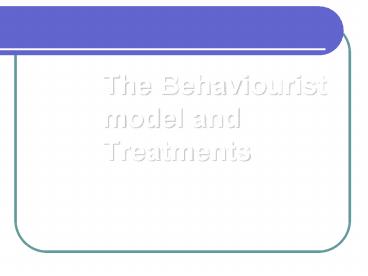The Behaviourist model and Treatments - PowerPoint PPT Presentation
1 / 14
Title:
The Behaviourist model and Treatments
Description:
The Behaviourist model and Treatments The Behavioural Model Basic Philosophy: That which has been learned can be unlearned. Learning occurring through a process of ... – PowerPoint PPT presentation
Number of Views:26
Avg rating:3.0/5.0
Title: The Behaviourist model and Treatments
1
The Behaviourist model and Treatments
2
The Behavioural Model
- Basic Philosophy
- That which has been learned can be unlearned.
- Learning occurring through a process of classical
or operant conditioning - Classical conditioning is learning via
association - Operant conditioning is learning via
reinforcement. - Stimulus and response
- Social Learning theory an extension of
behaviourism, believes that we learn by modelling
and coping the behaviours we witness around us.
3
The Behavioural Model
- At birth we are born with a tabula rasa (like a
blank sheet) and consequently all behaviour is
learned in same way. - For behaviorists Abnormal behaviour is the
consequence of abnormal learning from the
environment.
4
The Behavioral Model
- There is no difference, in the learning, between
normal and abnormal behaviours they are learned
in the same ways. This is by- - Classical conditioning
- Operant conditioning
- Social learning
- This is carried out via Stimulus and response
training.
5
Treatments
- Behaviour Therapy
- and
- Behaviour Modification
6
Behavioural Therapy
- Based on principles of Classical Conditioning
- CC involves automatic reflexive responses or
feelings (UCR) - Most common UCR to situations of danger is
fear/anxiety - Through association can lead to fear of specific
thing/situation - Anxiety disorder, e.g. phobia
- Aim of Behavioural Therapy is to remove the
association between fear and the object/situation
7
Technique 1Systematic Desensitisation (Wolfe,
1958)
- Counter Conditioning
- replacing fear response with an alternative and
harmless response. - Functional analysis
- construct a hierarchy of fearful situations
- Relaxation training
- The client is then trained in methods of
relaxation - Graduated exposure
- The client is then brought gradually into contact
with the phobic stimulus, following the
hierarchy.
8
Technique 2Flooding
- Aim to remove the learned association between
the stimulus and response - Procedure
- Inescapable exposure to the feared object or
situation - Lasts until the fear response disappears.
- Assumes that very high levels of fear/anxiety
cannot be sustained and will eventually fall. - http//www.youtube.com/watch?vW2nK_qmvJ7A
9
Technique 3Aversion Therapy
- Previous two techniques focus on removal of an
undesirable association. - This one aims to create an undesirable
association! - The aim is to remove from the individual any
undesirable habits by pairing them with an
unpleasant stimulus.
10
Evaluation of Behavioural Therapies
- Focus on symptoms, not deeper underlying causes
of behaviour. - Systematic desensitisation can be extremely
effective in treatment of simple phobias - (60-90 success rate, Barlow et al, 2002)
- Ethical issues in flooding and aversion therapy.
Intense fear and anxiety. Even systematic
desensitisation causes client to visualise or
experience feared situations. - Needs careful monitoring to ensure no long term
ill-effects. - Ignores any genetic or biological factors in
psychological disorders.
11
Behaviour Modification
- Based on principles of Operant Conditioning.
- Attempt to change voluntary controlled behaviour,
rather than reflexive behaviours involved in
classical conditioning.
12
Treatment 1Token Economy
- Increasing desired behaviour by positive
reinforcement. - Mostly used in institutions, e.g. psychiatric
hospitals. - Aim is to reduce levels of anti social behaviour
- Tokens given as reward for improved behaviour.
- Tokens can be exchanged for sweets, cigarettes
etc.
13
Treatment 2Social Learning Theory
- Cognitive element (not just Stimulus Response)
- Observation, vicarious reinforcement etc play a
role. - Modelling
- the patient observes others (the model(s)) in
the presence of the phobic stimulus who are
responding with relaxation rather that fear to
the phobic stimulus. - In this way, the patient is encouraged to imitate
the model(s) and thereby relieve their phobia.
14
Evaluation of Behaviour Modification
- Token Economy can improve behaviour/reduce anti
social behaviour - But, is this replicated once patient back in
community? - Reductionist approach to complex behaviour,
seeing people as stimulus-response machines. - SLT takes more complex view of human behaviour,
including cognitive processes of observation and
imitation. - Ignores any genetic or biological factors in
psychological disorders.

